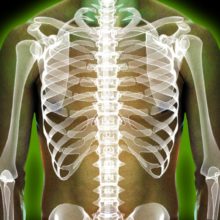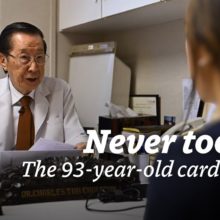Radiation – Worst Ways to Die
It’s almost two in the morning on the 26th of April 1986.
00:00:03
25-year old firefighter Vasily Ignatenko is part of the first response team tasked with putting out a fire at the Chernobyl Nuclear Power Station.
00:00:11
Chunks of highly radioactive graphite lie around the site.
00:00:14
The men pick up bits and kick them around, not knowing they are sealing their fate.
00:00:18
They do a commendable job; a heroic job, but Ignatenko and others on that team are just hours away from falling gravely ill.
00:00:25
One of the firemen jokes, “There must be an incredible amount of radiation here. We’ll be lucky if we’re all still alive in the morning.” Days later and Ignatenko’s pregnant wife has to bribe hospital staff so she can see her dying husband.
00:00:37
He’s just too radioactive to be close to. His skin is almost white, translucent. He’s unrecognisable.
00:00:43
He’s being eaten from the inside. Months later, after he’s passed, his daughter is born.
00:00:48
Her heart is malformed; she has cirrhosis of the liver.
00:00:51
She dies, just hours after childbirth.
00:00:54
What you just heard is an abridged version of one of the worst ways to die; one of the most painful, most brutal ways to leave this blue planet of ours. You could call Ignatenko’s downfall extreme.
00:01:05
He was a first responder to the worst nuclear plant disaster the world has ever seen. But death by radiation comes in many forms. Its horror manifests itself in myriad ways.
00:01:15
It can be fast – well, a few days won’t seem to pass by so fast when your body is eating itself – but it can also be slow, very, very slow. Let’s stay with the story of Ignatenko for now.
00:01:26
When he and the other firemen turned up at the power plant on that fateful early morning, they didn’t know what was really going on.
00:01:32
It’s true that one of the firemen joked about there being a possibility that they were exposed to high levels of radiation, but it was just that, a joke. It soon became a reality, though.
00:01:43
27 firefighters died from what is called acute radiation sickness, aka, ARS. In simple terms, that’s the sickness you get when you are exposed to massive amounts of radiation.
00:01:52
The number of actual radiation-related deaths was more like 4,000, but many of those deaths were of the slow kind.
00:01:59
There were other deaths, too, such as the fireman that died from external and internal radiation burns, as well as, get this, a “blistered heart.” Let’s hope you never have to hear those two words together for the rest of your life. Let’s now talk you through ARS.
00:02:11
There are usually four stages, starting with what the medical profession calls the prodromal stage.
00:02:18
This happens soon after the exposure, and it involves a lot of throwing up and leaking from the rear end.
00:02:24
In the case of Ignatenko, he was excreting bloody loose stools around 25 times a day. If that wasn’t bad enough, at times he threw up bits of his internal organs. We told you this was bad, and it gets worse.
00:02:36
His wife Lyudmila watched on as her husband slowly fell apart.
00:02:40
She actually risked her own life being near him, because the father of that fetus in her womb was radioactive himself.
00:02:47
She watched helplessly as staff struggled to put slippers on his swollen feet – another of the symptoms.
00:02:52
She witnessed staff not being able to clothe him in a hospital gown. His body she said had transformed. He was taking on different shapes.
00:03:00
In her own words, she said, “Every day I met a brand-new person. The burns started to come to the surface.” The lesions on his body spread, making his skin look like a glossy white film. This came as a surprise to her, because at one point he seemed to get better. It was as if the sickness was abating. It wasn’t.
00:03:16
What was happening is that he was experiencing stage two of ARS, the latent stage. This can last hours or weeks.
00:03:22
Some people can recover after ARS, but those that don’t are going to experience literal hell on Earth.
00:03:28
The radiation will destroy the bone marrow in the body, which can lead to deadly infections and hemorrhage.
00:03:33
The GI tract can be destroyed as can the cardiovascular and Central Nervous System. You don’t have much chance of survival after that.
00:03:40
It all depends on how much radiation a person is exposed to. Some folks might be kept alive with the help of medical staff.
00:03:46
Antibiotics can fight infections; blood transfusions can supply much needed white blood cells, but the fact is, even if the person gets through the month there can be many, many complications. Let’s now talk about the skin.
00:03:58
If a person is poisoned by radiation what often happens at first is their skin will become reddened and may feel itchy.
00:04:04
This can lead to blisters, which may scar and in worse cases, may even kill the skin’s cells, something called necrosis.
00:04:11
As for poor Ignatenko, he suffered from something called desquamation, which basically means his skin started to peel off.
00:04:19
The blood vessels in his skin failed to work, and so he lost tissue at deeper levels. This is why his wife said he barely looked human at that point.
00:04:27
We should say that hair loss is almost guaranteed, but that’s hardly a concern when your skin has fallen off.
00:04:32
Stranger things can happen months after radiation exposure. Listen to this.
00:04:36
It’s what one guy said about a friend of his who was at that disaster site. “My neighbor—he was also there, he worked a crane.
00:04:42
He got black, like coal, and shrunk, so that he was wearing kids’ clothes.” What the hell? You see, we’ve only explained to you some of the horror that happened to people who died just days or weeks after exposure, but there were many others who would succumb in months or years.
00:04:58
Sasha Yuvchenko could tell you all about prolonged agony.
00:05:01
On the night of the disaster he held a heavy reactor hall door open so men could get through. The three guys that went in died within two weeks.
00:05:10
He survived, but that part of his body that held the door was exposed to massive amounts of radiation.
00:05:15
About an hour later he was vomiting.
00:05:17
He had a searing pain in his throat. More time passed and he couldn’t stand up.
00:05:21
At the hospital the staff measured the amount of radiation in his body and he was given a 50/50 chance of surviving.
00:05:27
He was sent to Moscow with other men who’d been exposed.
00:05:30
Five of them died quite quickly, something which Yuvchenko would later say was a blessing.
00:05:34
In a matter of days all his hair had fallen out, not just on his head, but on his entire body.
00:05:41
He said most men suffered from skin rashes, huge ugly rashes that burned. Some were given bone-marrow transplants and all the men received multiple blood transfusions. He experienced that latent stage, when the sickness seemed to calm down, but it came back with a vengeance.
00:05:56
One day he pulled back the sheets on his bed only to see piles of black dead skin. The part of his body that had held that door had become horribly swollen.
00:06:03
The skin died around his shoulder and arm, and it was just plain luck that he managed to keep it.
00:06:09
Years later it would be almost half the size of his good arm.
00:06:12
For many years the affected body parts would just break out in ulcerations, which meant for much of his life he was covered in bandages after having operations. He actually felt like one of the fortunate ones, because he witnessed his friends losing their eyesight or succumbing after bone-marrow transplants.
00:06:26
You see, the radiation destroys bone-marrow cells, and when they go, the victim doesn’t have the white blood cells that fight infections.
00:06:33
They are vulnerable; sitting ducks.
00:06:36
For those who survived like Yuvchenko, their lives were forever changed. They were likely infertile, but they were told not to bother having kids anyway. There was a likelihood that the kids would be born malformed or would develop leukemia. Worse still, the survivors became pariahs.
00:06:50
People looked at them like they were the living dead, dangerous carriers of radiation, and so people would cross the street when they saw them coming.
00:06:57
Then there are the ones that died of radiation-related cancers.
00:07:00
No one can say exactly how many people that was, but it’s thought that maybe as many as 270,000 people in Ukraine, Russia and Belarus developed cancers because of the disaster. It’s estimated that around 93,000 of them died, a lot of them just children. Many women were exposed to high levels of radiation, but because they never suffered the more extreme symptoms of radiation poisoning, they didn’t think too much about it. Then they had kids, sick kids.
00:07:26
It should also be said that many people drank milk from cows that grazed on contaminated land.
00:07:31
Some of those kids developed cancer early on in life, but others suffered from very strange and macabre-sounding birth defects.
00:07:37
The human embryo and fetus are very sensitive to radiation, so while mom might look fine, it doesn’t mean her newborn will be.
00:07:44
Some kids whose parents had been exposed to high levels of radiation were born with a club foot, or a cleft palate, or a cleft lip.
00:07:51
Some had an extra finger or extra toe, while others had digits on their hands or feet that were fused together.
00:07:56
Believe it or not, in 1993 there were reports of a two-headed baby being born in the former Soviet republic of Moldova.
00:08:04
She not only had two heads, but also had two hearts, two sets of lungs and two spinal cords. Radiation was blamed. In 2016, there were close to 2.4 million people registered with Ukraine’s health ministry that were getting Chernobyl-related treatment. Almost half a million of them were children. You can visit homes for children today and you’ll find kids that have suffered tremendously because of radiation exposure. One child we found had bad blood circulation, another had a heart condition, another had two swollen left kidneys and a stomach condition that makes her life miserable, not to mention a nervous system condition that keeps her in a constant state of stress. All the kids came from areas where there was radioactive land. They’ve become known as the, “Children of Chernobyl.” We’ve concentrated largely on the Chernobyl disaster, but death from radiation has taken out a lot of people, some of them well-known figures. Take for instance, Marie Curie, the Nobel Prize winning physicist who discovered polonium and radium.
00:08:25
She used to love the blue-green glow of her test tubes that contained radioactive isotopes. She’d walk around with them in her pockets. That would lead to her downfall.
00:08:32
She became almost blind, severely ill, and eventually died because of her ignorance. Then there was the wealthy American socialite named Eben Byers.
00:08:40
In the 1920s, he was a huge fan of drinking radium dissolved in water.
00:08:44
A glass a day keeps the doctor away, he told his friends and the public, only to gradually become sick, lose weight, lose his teeth, and the best part of his jaw. When he died there were holes in his skull.
00:08:55
A similar thing happened to who we now call the radium girls.
00:08:58
Those young women were employed to paint watch faces with radium infused glowing ink, something which was great for soldiers and that took off as a fashion. Little did they know that when they sharpened their paint brushes by putting the bristles in their mouth, they were ingesting radium.
00:09:13
Many of them lost teeth, their jaw, and some died painfully and slowly.
00:09:17
And let’s not forget the former K.G.B. agent Alexander Litvinenko.
00:09:21
After gaining political asylum in the UK in 2006, his cup of tea was dosed with polonium-210. Within weeks, he was a dead man.
00:09:29
Some believed that this kind of hit was a big statement and a warning to anyone that dare defy the almighty Putin.
00:09:35
The poison wasn’t designed to kill Litvinenko quickly, but to make him suffer as much as possible.
00:09:40
Now you need to watch, “The Cell, Russia’s Horrific Poison Laboratory of the Soviet Secret Services.” Or, “How I Survived Chernobyl.”







